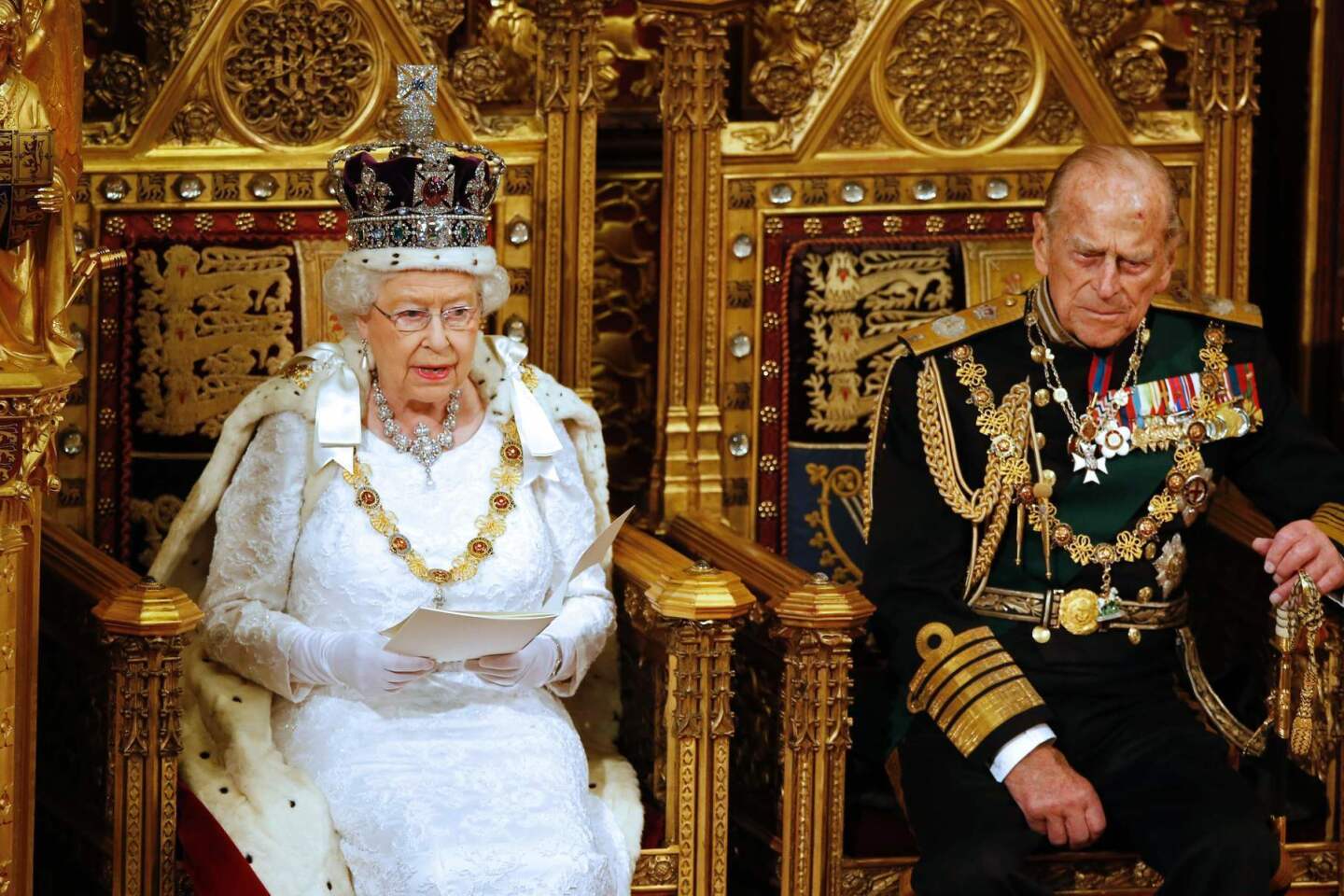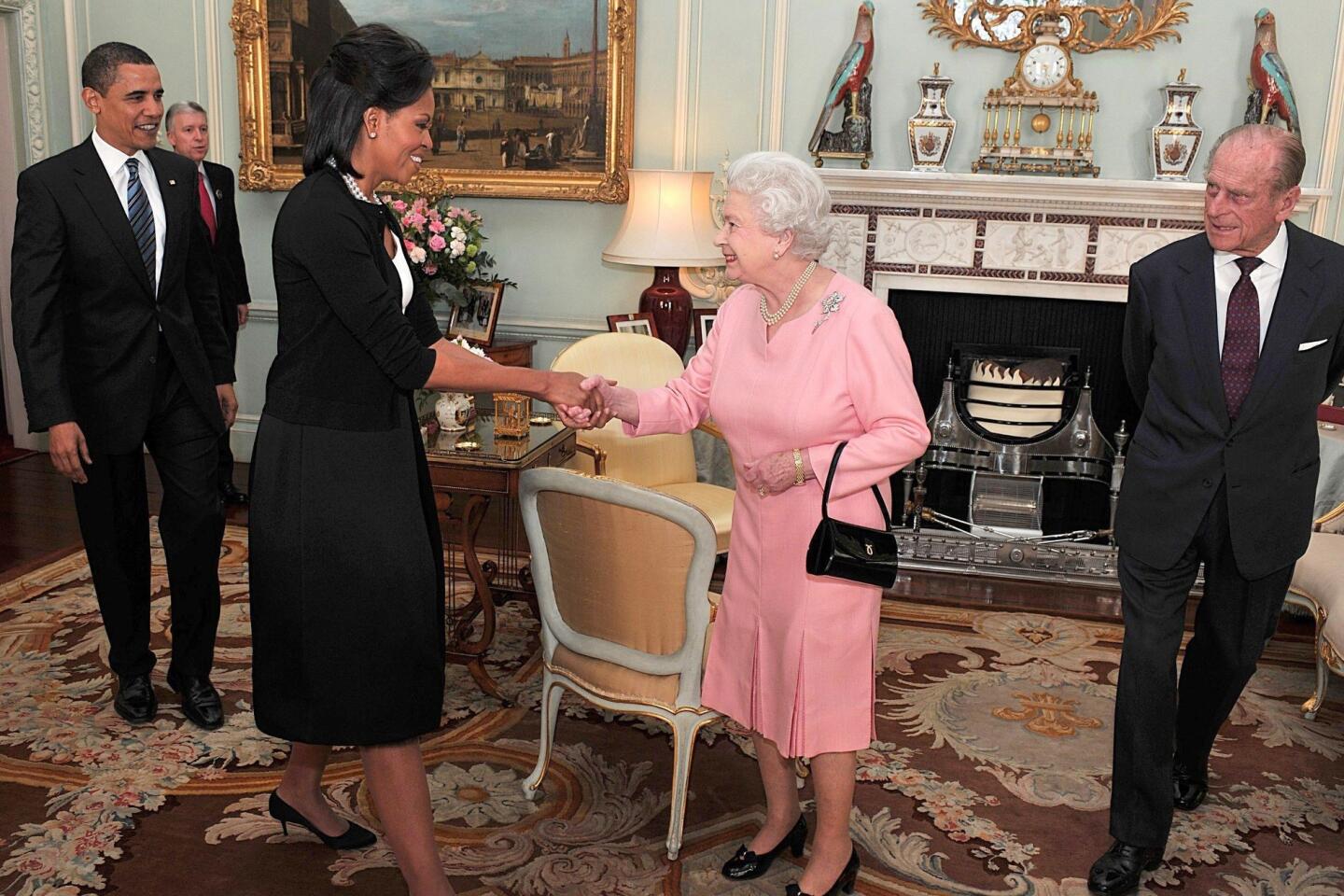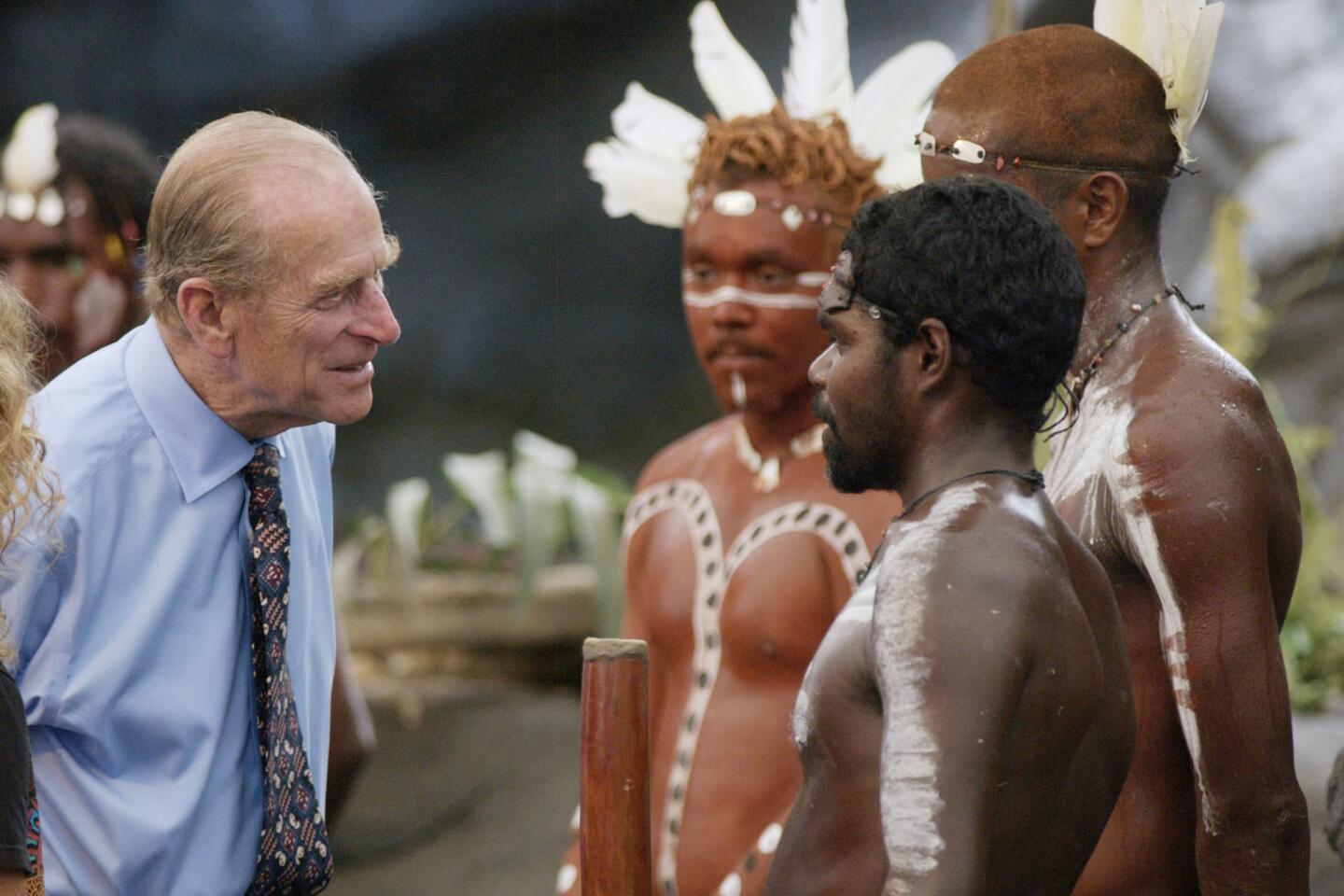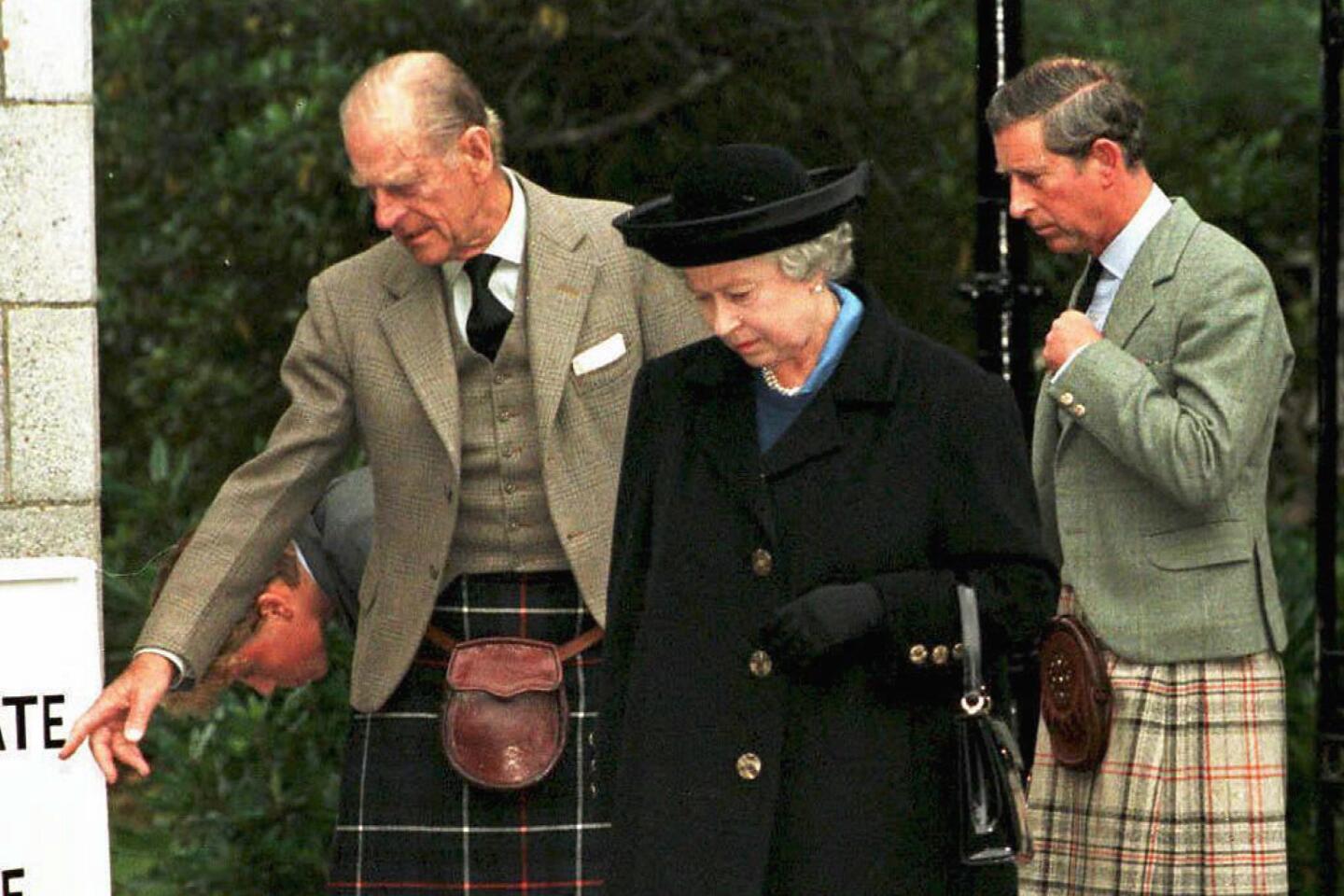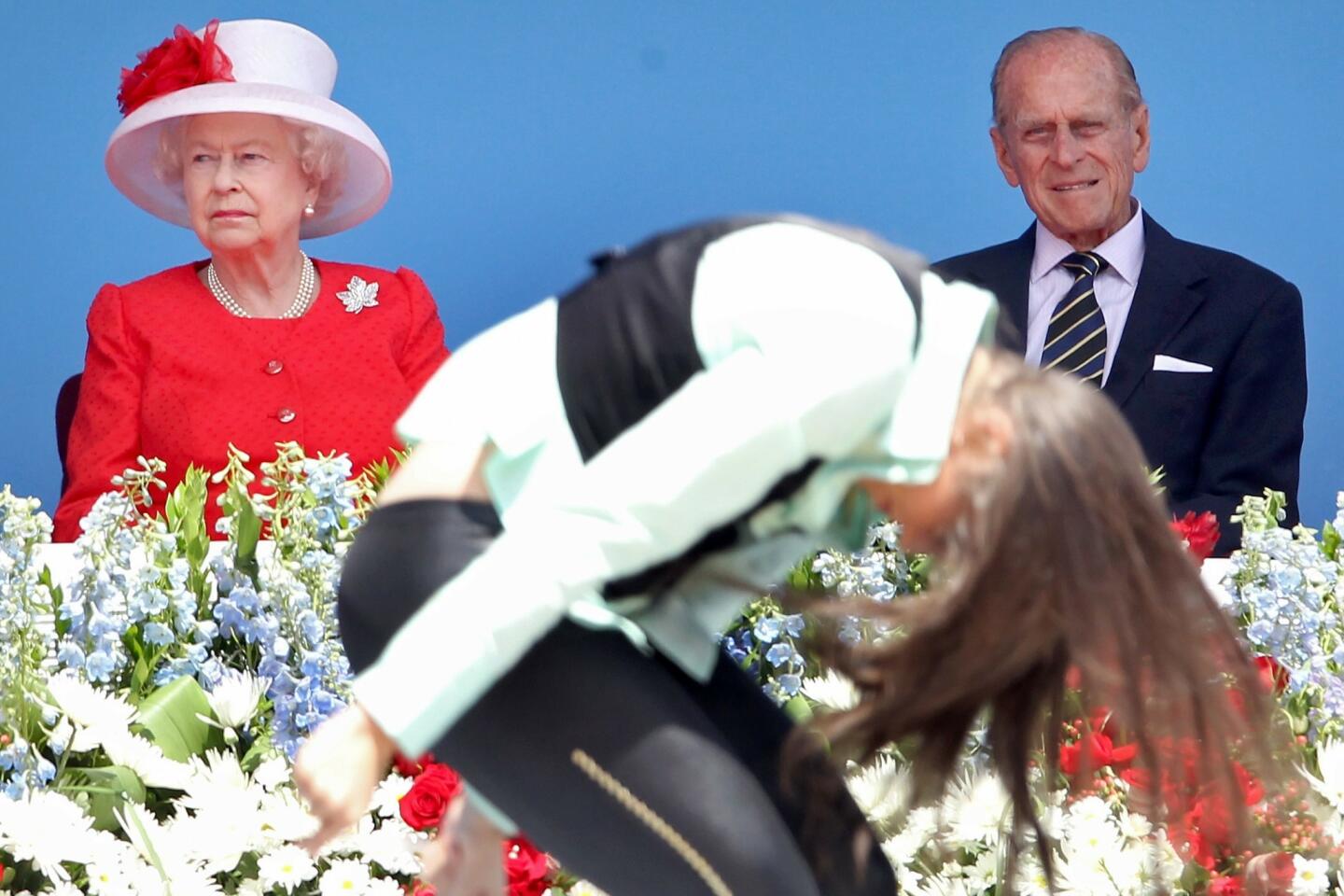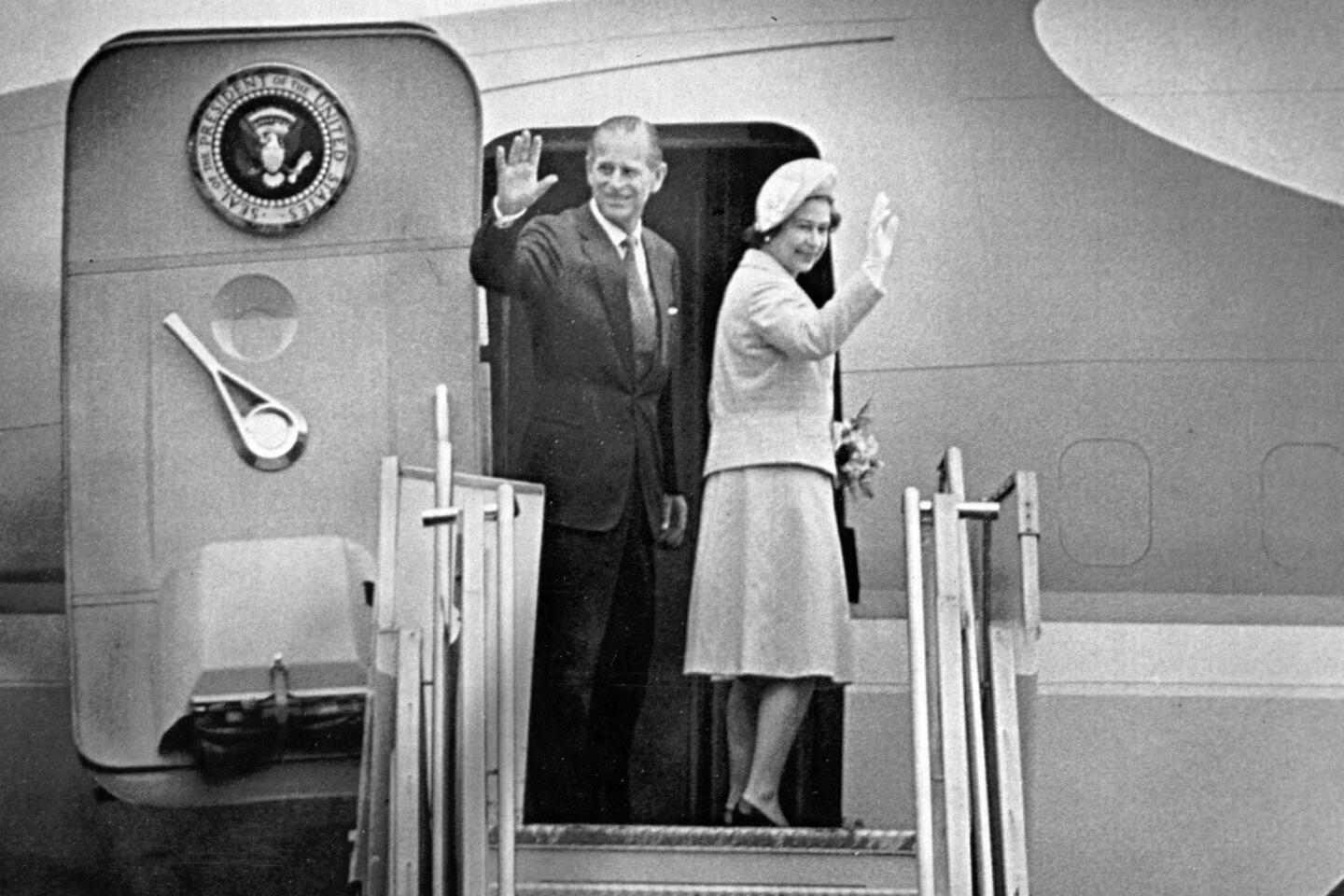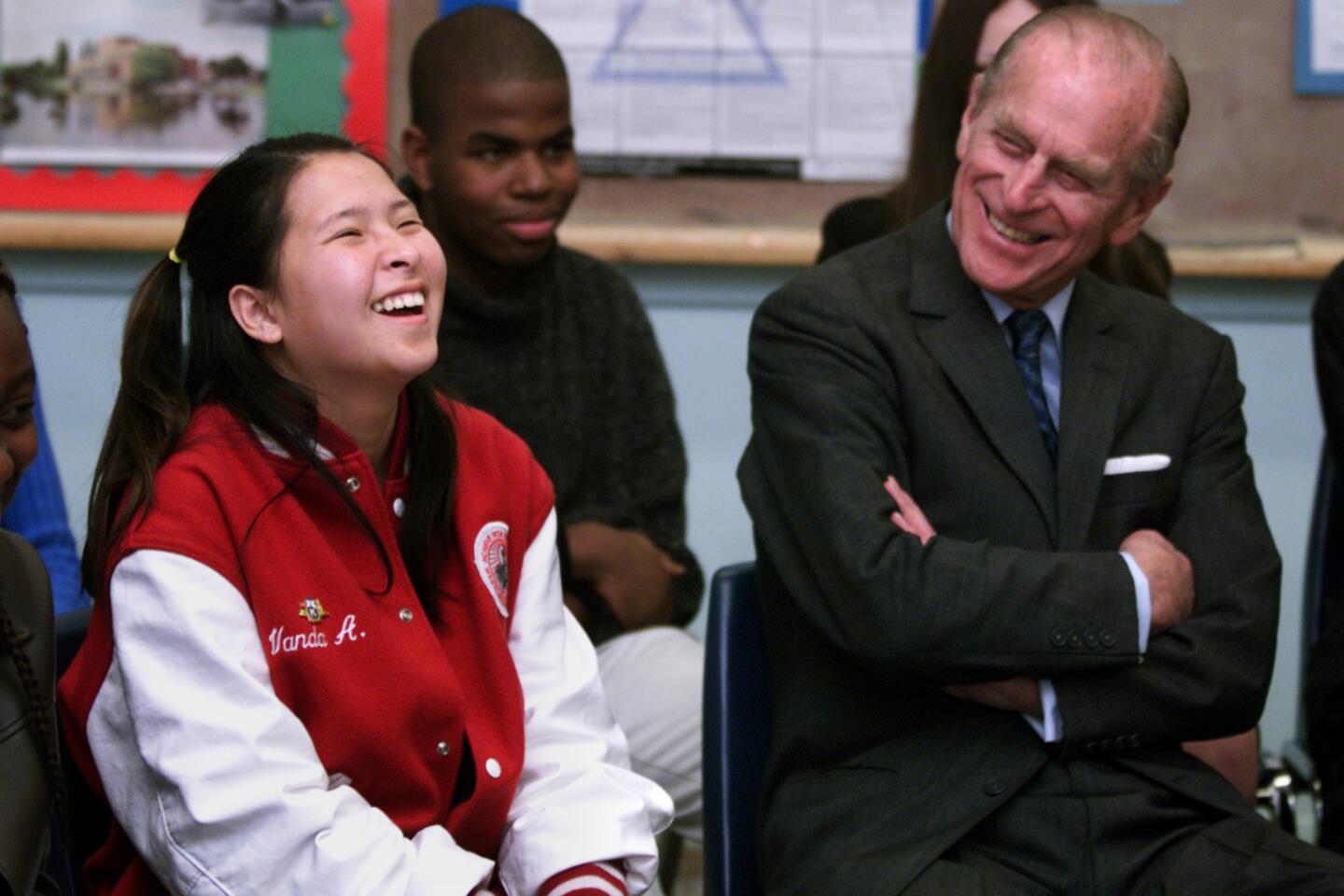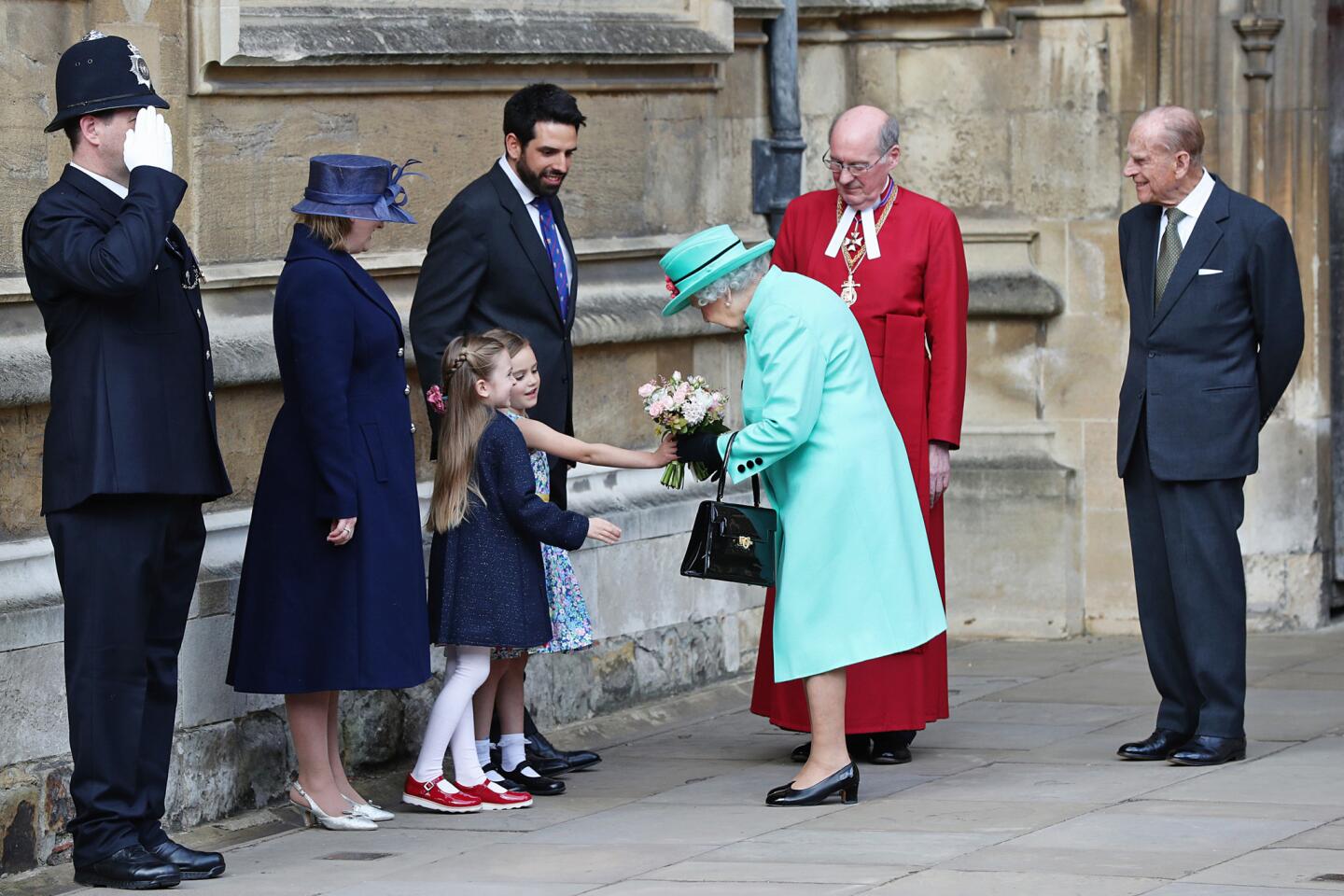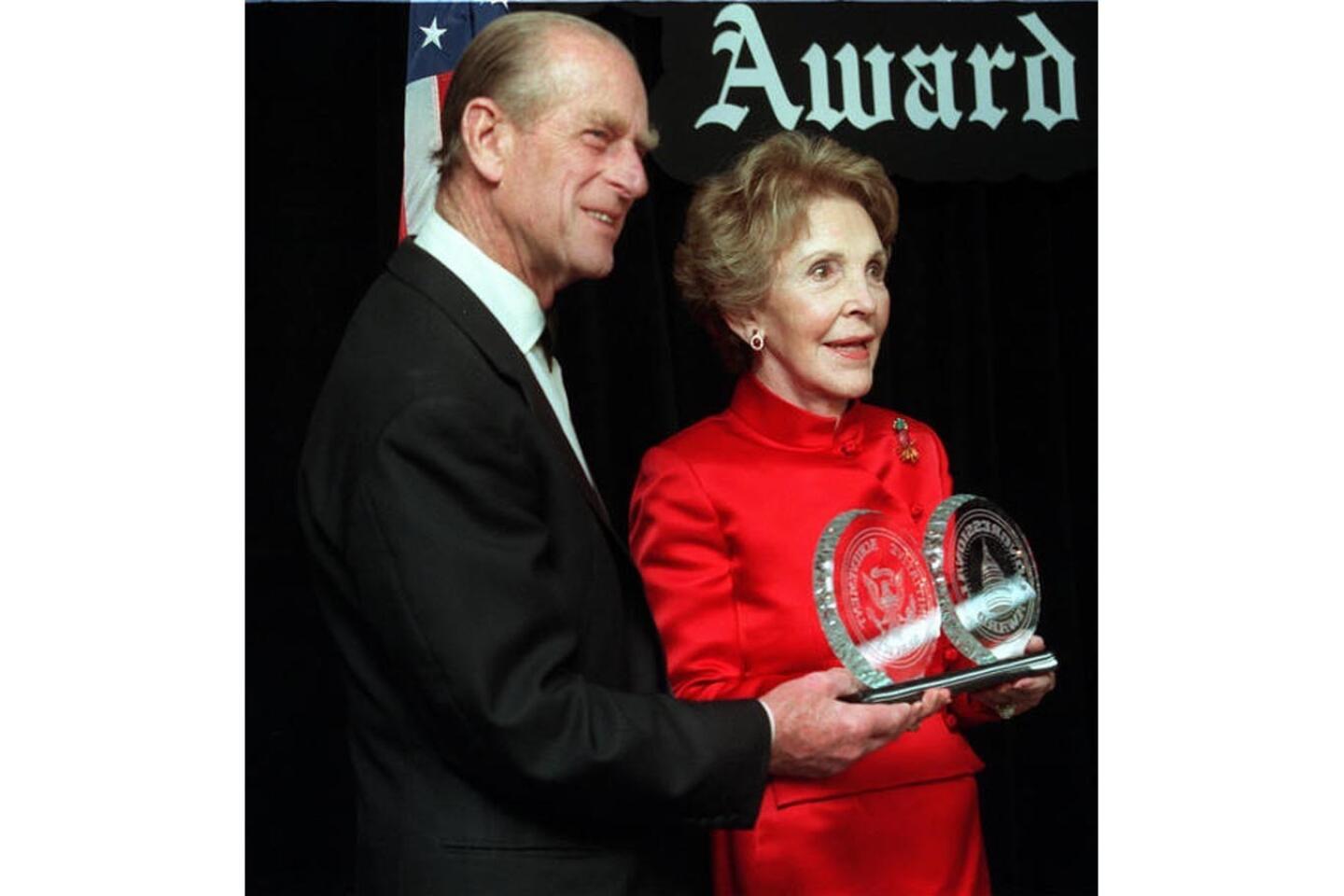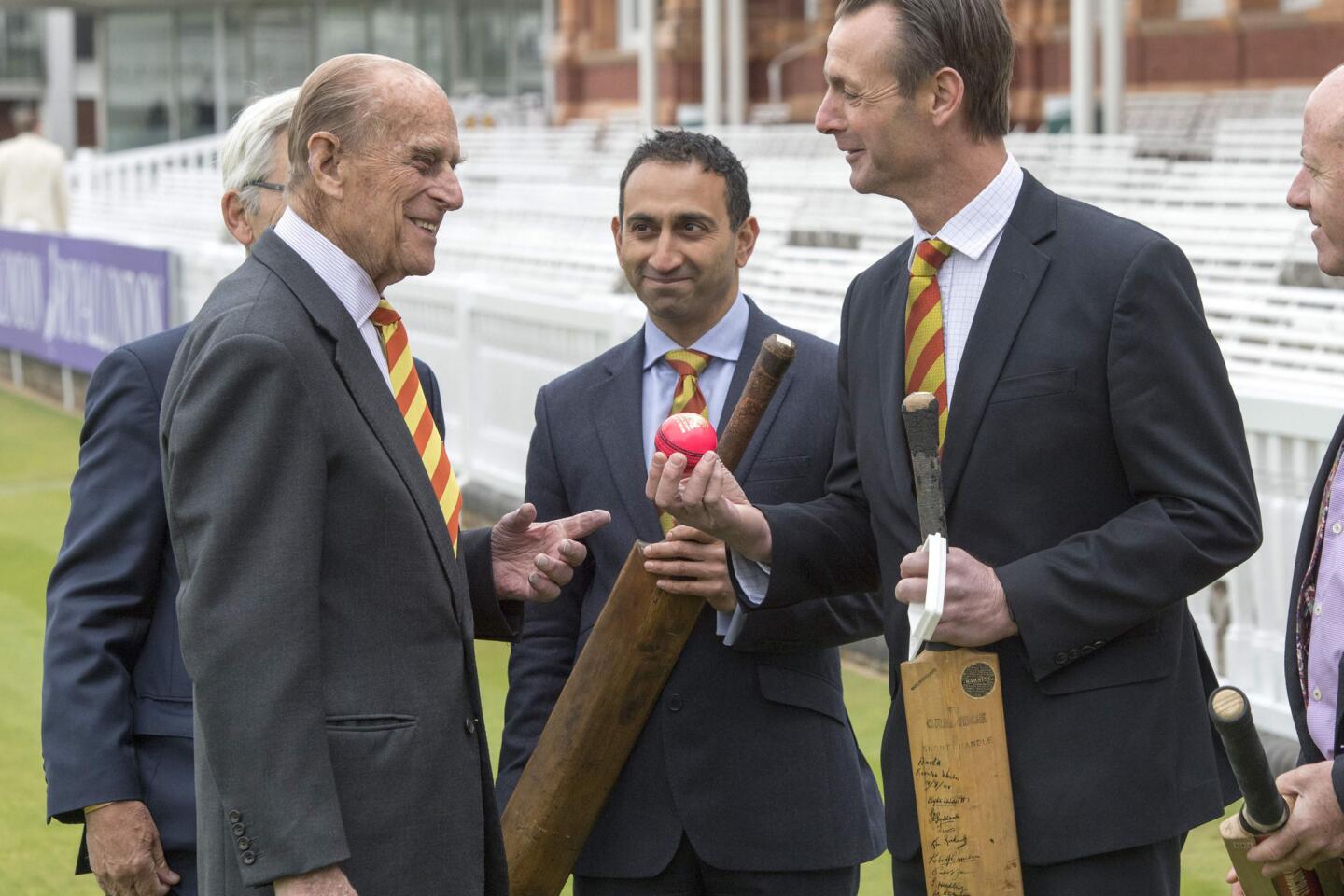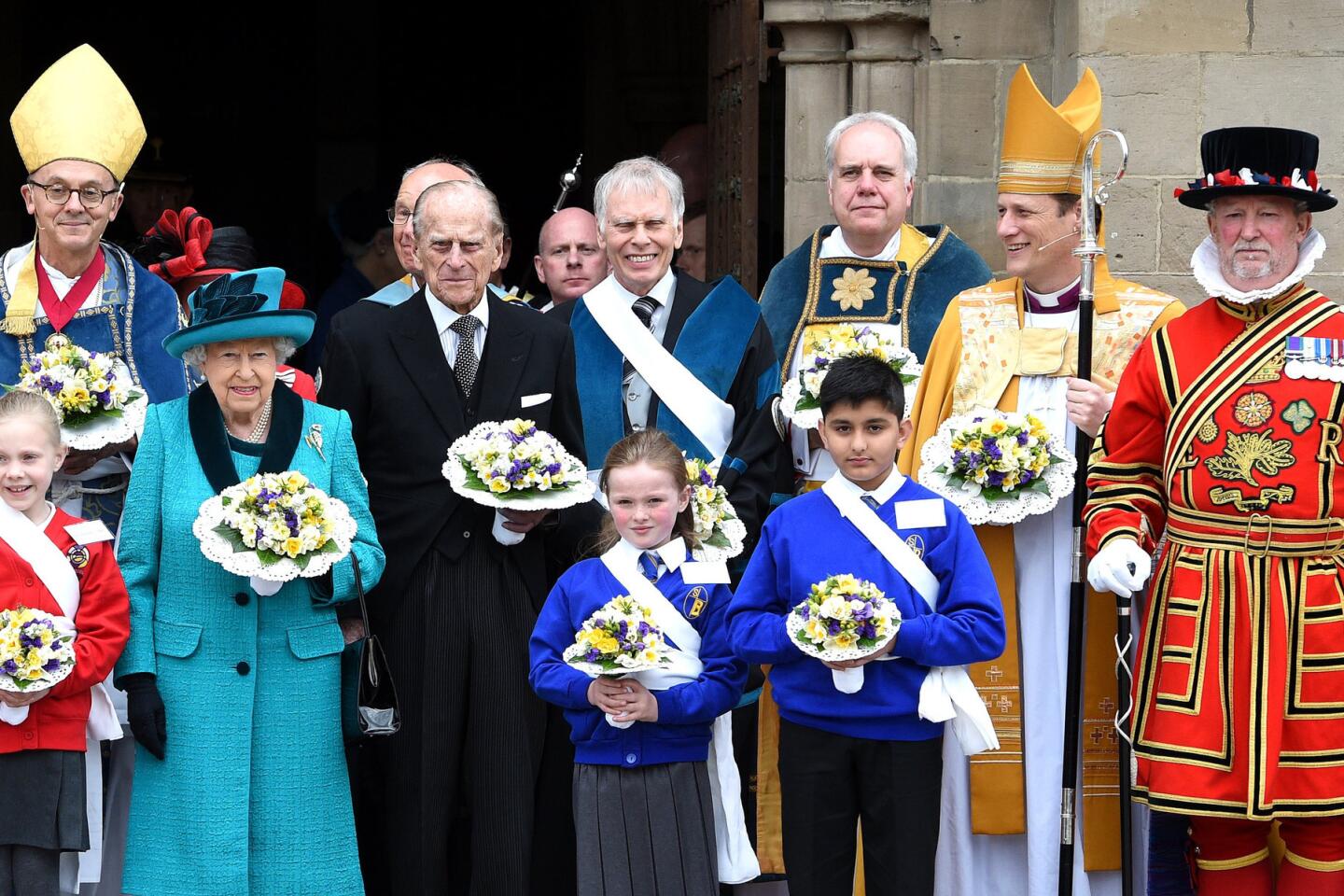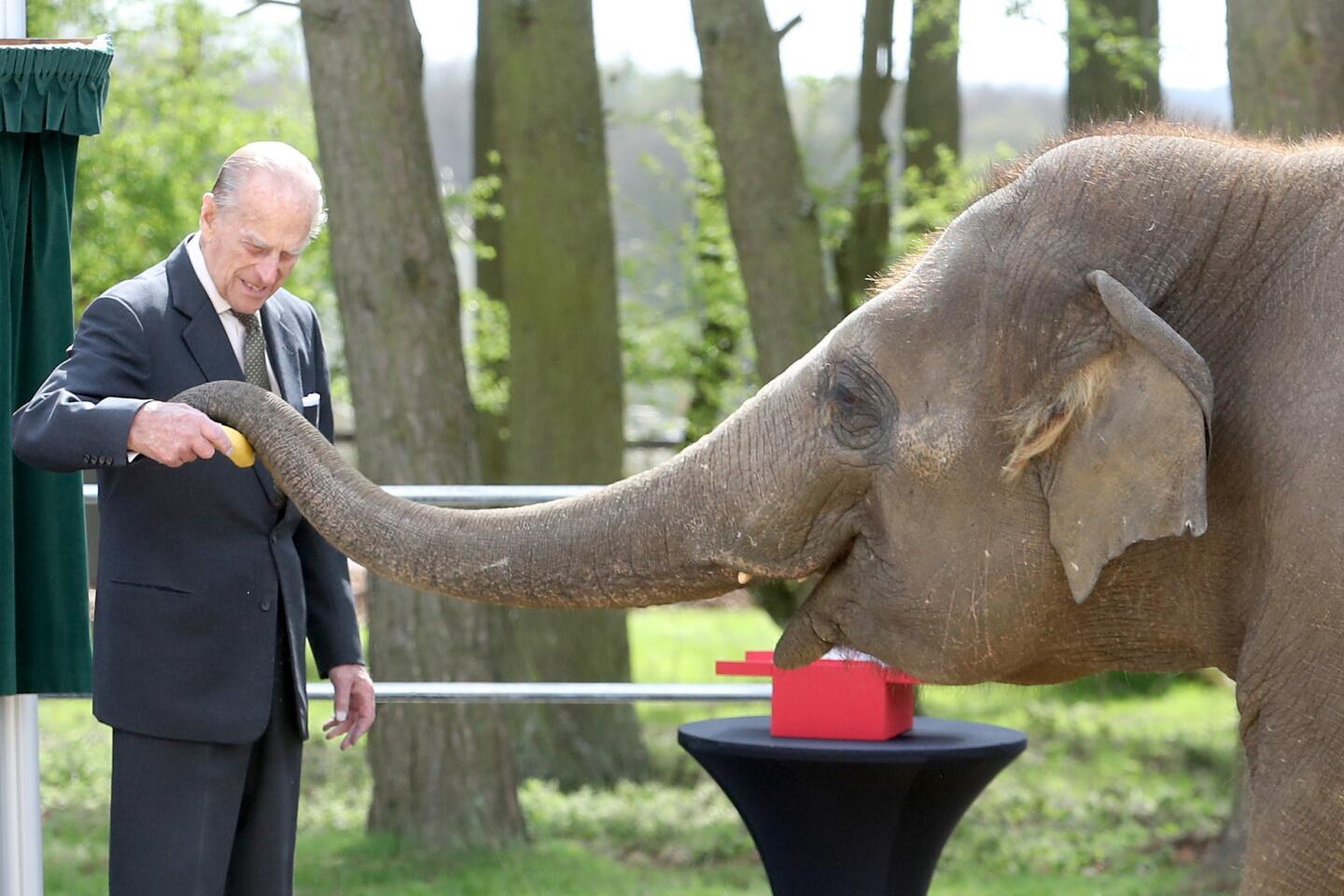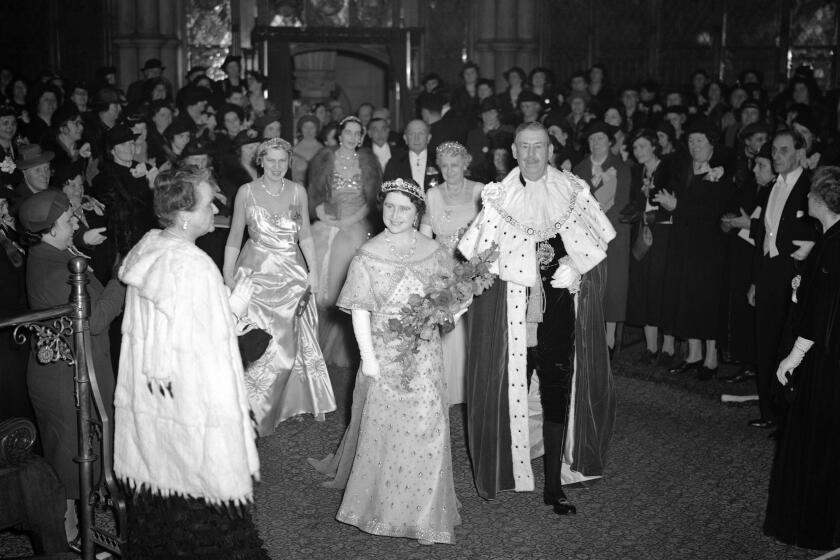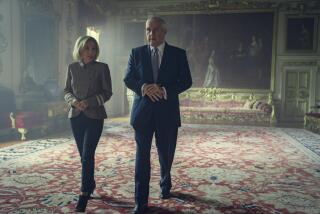Prince Philip, Queen Elizabeth II’s husband and closest confidant and advisor, dies at 99

The Duke of Edinburgh, Queen Elizabeth II’s husband, was the undisputed master of the British royal household for more than seven decades.
- Share via
It was an enduring alliance that outlasted the Cold War, 15 prime ministers, war and peace in Northern Ireland and Britain’s union with Europe — followed by the country’s shattering decision, 43 years later, to leave.
Side by side for as long as most Britons could possibly remember, Prince Philip and Queen Elizabeth II stood as a reassuring constant even during the most trying or turbulent times, an epic love story that seemed unshakable.
But the longest marriage of a reigning monarch in British history came to an end Friday when the prince — two months shy of his 100th birthday — died at Windsor Castle in England. The flag above Buckingham Palace was immediately lowered to half-staff, and the official announcement of Philip Mountbatten’s death was posted on the palace gates.
“It is with deep sorrow that Her Majesty The Queen has announced the death of her beloved husband, His Royal Highness The Prince Philip, Duke of Edinburgh,” Buckingham Palace said in a statement Friday, just after noon in Britain. “His Royal Highness passed away peacefully this morning at Windsor Castle.”
Standing outside No. 10 Downing St., Prime Minister Boris Johnson praised Philip for a life of service and endurance.
“Like the expert carriage driver that he was, he helped to steer the royal family and the monarchy so that it remains an institution indisputably vital to the balance and happiness of our national life,” Johnson said.
“Over the course of his 99-year life, he saw our world change dramatically and repeatedly,” President Biden and First Lady Jill Biden said in a statement. “From his service during World War II, to his 73 years alongside the Queen, and his entire life in the public eye — Prince Philip gladly dedicated himself to the people of the U.K., the Commonwealth, and to his family.”
During the COVID-19 pandemic, Philip and the queen had been staying at Windsor Castle, west of London. Though he enjoyed robust health for most of his life, he was hospitalized for a month this year, from Feb. 16 to March 16, during which he underwent a heart procedure.
He was treated for chest pains in 2011, was hospitalized for two days in 2017 and was hospitalized again for 10 days in 2018 for a hip replacement. He was forced to give up driving in 2019 — at the age of 97 — after smashing into another car while driving his Land Rover.
Britons pay tribute to Prince Philip, with the BBC cutting away from its regular programming to broadcast the national anthem, ‘God Save the Queen.’
Prince Philip never held the official title of prince consort, as did Queen Victoria’s Prince Albert, but he nonetheless was Queen Elizabeth II’s closest confidant, most reliable political advisor and the undisputed master of the royal household for more than seven decades.
Philip was known equally as a curmudgeon and a charmer who could quickly put nervous guests at ease with an easy (and sometimes outrageous) one-liner. Courtiers, his own children and the queen herself backed down under the quick flash of his temper, and guests at Buckingham Palace were expected to stay up to speed with his lively intellect and encyclopedic command of facts or were hastily dismissed as being not worthy of the duke’s time.
While Elizabeth presided over affairs of state, Philip championed dozens of charities, including the Duke of Edinburgh’s Award, which has promoted self-reliance, physical development and other personal accomplishments for more than 6 million youths around the world.
He also set down the ground rules for rearing of the royal children, wrote books about horses and equestrian sports, oversaw the palaces and handled hundreds of official engagements every year until he retired from his official public schedule in August 2017. (“Unveil your own damn plaque,” read a cartoon drawn specially for the occasion, to Philip’s delight.) He was nearly always at the queen’s side during more than 73 years of marriage.
“Prince Philip is simply my rock. He is my foundation stone,” the monarch said at a lunch in 1997 honoring their 50th wedding anniversary. “He is someone who doesn’t take easily to compliments, but he has quite simply been my strength and stay all these years, and I and his whole family … owe him a debt greater than he would ever claim or we shall ever know.”
Philip, for his part, seldom talked about his contributions to the royal enterprise, though he was known on rare occasions to reflect on what he had given up to be the man who walks two paces behind the queen, the husband of one monarch and the father of presumably the next, with no historic role of his own.
“It was not my ambition to be president of the Mint Advisory Committee,” he told the Independent on Sunday newspaper in 1992. “I didn’t want to be president of [the World Wide Fund for Nature]. I was asked to do it. I’d much rather have stayed in the navy, frankly.”
His chief contribution in the end was simply to have been there for the queen: a man of keen rationality and wide reading who in some ways intimidated her, who was not legally answerable to anyone and who was available as a voice of reason and dissent when all around had a habit of agreeing with her.
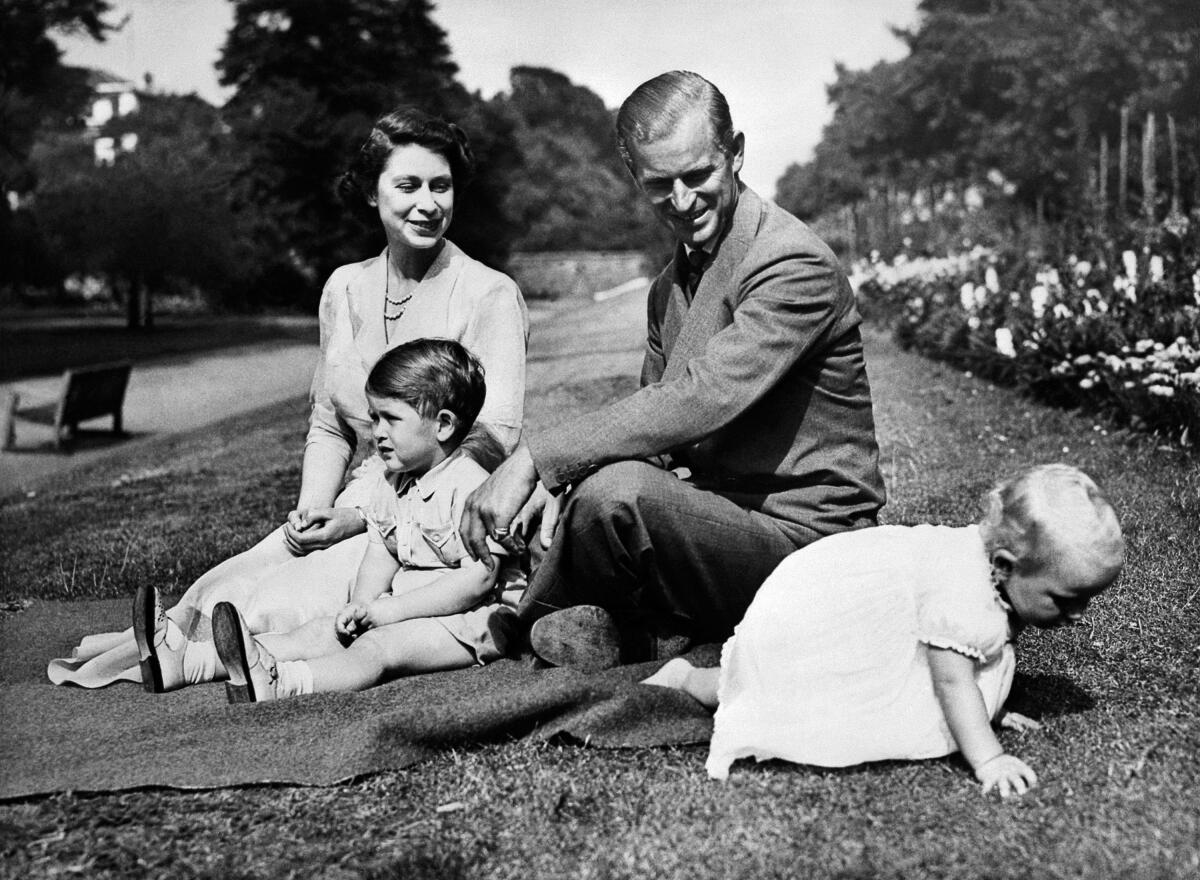
“He had a slight reputation for pushiness and being opinionated … and he is as right-wing as ever, but there’s never been the slightest suggestion that he influenced the queen in that way,” said Robert Lacey, the British historian best known for his work on the award-winning drama “The Crown.”
“We can now see he was free to state his own opinions because he had no constitutional responsibilities,” he said. “So that made him a particularly strong and useful pillar for the queen.”
A former government secretary told the Daily Telegraph in 2001 how the Duke of Edinburgh had once quizzed him about a policy issue in his department.
“‘What’s the object of the exercise?’ he asked me. I stumbled through the answer and tried to explain that the aim was a bit of A and a bit of B. ‘Yes,’ he said, ‘but which is it — A or B?’ I replied, probably rather incoherently, that it really was a mixture of both. ‘I’d always thought that what was wrong with this country was that all the best brains went into the civil service,’ said Prince Philip, ‘but that was before I met you!’ — and walked away.”
He also had a knack for the painfully politically incorrect remark. Amid the recession of 1981, as more Britons sought public assistance, he observed: “Everybody was saying we must have more leisure. Now they are complaining they are unemployed.” When the royal couple were introduced in 2002 to a teenage army cadet who had been blinded in an Irish Republican Army bombing, the queen asked the 15-year-old boy how much sight he had left. “Not a lot, judging by the tie he’s wearing,” Philip quipped, as the crowd fell silent.
But Philip was also the ultimate salt-of-the-earth English country gentleman. Royal hunting weekends would not be complete without the sight of Philip, his head wreathed in smoke, barbecuing the day’s take of pheasants. He was an enthusiastic sailor, polo player and carriage driver who went bolting with his horses around the royal estates until well into old age, when Elizabeth begged him to give it up. (The Daily Mail carried photos of the prince once again at the reins of his carriage in November 2017, prodding his horses around Windsor Castle at the age of 96.)
Prince Philip, Queen Elizabeth II’s husband, whose died Friday, was the longest serving royal consort in British history.
Philip, grandson of Greece’s King George I, was the product of a royal family that had strong blood connections to most of the other monarchies in Europe. He came into the world on June 10, 1921, as Prince Philip Schleswig-Holstein-Sonderburg-Glücksburg of Greece and Denmark, born on the kitchen table of the royal holiday villa on the island of Corfu.
Barely 18 months later, with his grandfather killed and his father threatened with a firing squad by a revolutionary court, he was evacuated with his family on a British warship and wound up in France. Philip was eventually shuttled off to a series of top-flight British schools at the behest of English relatives.
He made a success of it, which was a good thing, because his family was self-destructing: His father abandoned the family to take up life as a playboy, his mother fell into mental illness, and his sisters were married off to German nobles — one of them an aide to Heinrich Himmler, head of the Nazi Schutzstaffel, or SS.
“It’s simply what happened. The family broke up,” he said when asked about it years ago. “My mother was ill, my sister was married, my father was in the south of France. I just had to get on with it. You do. One does.”
From the tough and austere Gordonstoun school in Scotland, Philip took the advice of his uncle and mentor, Lord Louis Mountbatten, and entered Britannia Royal Naval College in Dartmouth. From there, he amassed a creditable service record as a naval officer during World War II.
But it was a short interlude during his time at Dartmouth that sealed his future. The royal family paid a visit there with the then-13-year-old Elizabeth, a distant cousin of Philip, and Lord Mountbatten apparently arranged a meeting. The princess was, by many accounts, entranced by the handsome 18-year-old cadet, exactly as Lord Mountbatten had hoped.
Philip was invited to spend Christmas with the royal family at Windsor Castle in 1943, and what might have been a girlish crush evolved into a full-fledged romance.
Philip took the name Mountbatten, the anglicized form of his mother’s name, Battenberg; he became a citizen of Britain and was received into the Church of England. On the eve of his wedding, he was showered with titles: Duke of Edinburgh, Earl of Merioneth, Baron Greenwich and, ultimately, His Royal Highness.
On Nov. 20, 1947, a nation still weathering the debilitating and depressing aftermath of World War II brightened at Philip and Elizabeth’s fairy-tale wedding at Westminster Abbey, complete with a shining carriage parading the couple through the streets.
The two danced that night to “People Will Say We’re in Love,” their favorite song from the musical “Oklahoma!” — a melody that was to become their theme through the years.
After their first two children, Charles and Anne, were born, an event occurred that would change their lives forever: the death of Elizabeth’s 56-year-old father, King George VI. Philip was 30; his wife, just 25.
Philip’s successful naval career came to an abrupt end. With Elizabeth’s stately coronation at Westminster Abbey in 1953, Philip swore a new kind of allegiance to his wife.
Philip as a father could be stern and brutally unforgiving of weakness. He insisted that Charles attend Gordonstoun as he had, turning the sensitive boy’s school years into what Charles would later describe as a misery. Philip was impatient with what he saw as his eldest son’s softness and extravagance, sometimes reducing the young man to tears with a cutting remark.
And it was Philip, Charles’ biographer Jonathan Dimbleby revealed, who urged Charles to marry Lady Diana Spencer, though the prince didn’t know her well (and was probably still in love with Camilla Parker, who had been deemed unsuitable as a royal mate).
“Philip felt he was raising a future king,” Lacey said.
In the end, the royal couple saw three of their four children go through painful divorces.

Philip, perhaps even more than his wife, worried that the royal children’s marital troubles being splashed daily in the tabloids could erode the aura of mystery, respectability and impeccable standards surrounding the palace, without which he did not believe the monarchy could survive.
In a series of warm but frank letters to Diana as her marriage was breaking up, Philip urged the Princess of Wales to stay the course.
“We do not approve of either of you having lovers. Charles was silly to risk everything with Camilla for a man in his position. We never dreamed he might feel like leaving you for her,” he wrote in one of his typewritten letters, which he usually signed, “Love, Pa.”
But he also asked the princess: “Can you honestly look into your heart and say that Charles’ relationship with Camilla had nothing to do with your behavior towards him in your marriage?”
This presumption that wives cause their husbands to have affairs raised red flags for the many who speculated that Philip carried on a series of liaisons during his marriage with a well-known author, an actress, a Russian ballerina and even another member of the royal family. All of the subjects of the rumors denied them, suggesting that Philip seemed interested in playful banter and intellectual conversation, not affairs.
When Diana was killed in 1997 in a car crash in Paris, along with Egyptian playboy Dodi Fayed, his father, billionaire Mohamed Fayed, former owner of Harrods department store, publicly accused Philip of ordering the princess’ murder. An inquest found “not a shred of evidence” to support the allegation, but not before six months of hearings that filled the British tabloids.
More recently, Philip found himself in the crosshairs of “The Crown,” which in its second season on Netflix in 2018 opened for public reexamination the prince’s partygoing ways and the painful effect the rumors of his purported infidelities had on the steadfast queen.
And Philip was largely silent when Prince Harry and the former Meghan Markle appeared in a sensation-causing interview last month with Oprah Winfrey, during which Meghan spoke of the racism and icy response to her concerns about her mental health she experienced from some in the monarchy.
Well into their 90s — preparing to celebrate their 70th wedding anniversary, the first British monarchs ever to do so — the queen and Philip were confronted in 2016 with perhaps the biggest challenge of Elizabeth’s reign: Britain’s historic vote to leave the European Union.
Britain had linked its future to Europe under Elizabeth’s watch, in 1973, and throughout the fractious Brexit campaign that sundered public opinion and threatened to divide the United Kingdom, there were persistent questions about whether or how the royal family would respond.
The Sun had a bombshell story saying Elizabeth had made private remarks skeptical of the EU on two occasions, and the Guardian came back with a report that the royal family was so upset over the story that there were plans afoot to have Philip make a public statement urging Britons to stay the course with Europe.
In the end, no statement was made. The queen and her consort maintained their usual stance of constitutional neutrality — rulers who don’t quite rule, who preserve the monarchy by remaining rigorously outside the most important decisions confronting the British state.
Philip, for his part, always seemed a bit mystified about what he was actually supposed to do as the husband of Elizabeth II.
“There was no precedent. If I asked somebody, ‘What do you expect me to do?,’ they all looked blank. They had no idea,” he told the BBC when he turned 90.
Somehow, he managed. When he retired from public life, he told the interviewer, it was high time. “It’s better to get out before you reach the sell-by date.”
Murphy is a former Times staff writer and editor.
More to Read
Start your day right
Sign up for Essential California for the L.A. Times biggest news, features and recommendations in your inbox six days a week.
You may occasionally receive promotional content from the Los Angeles Times.
